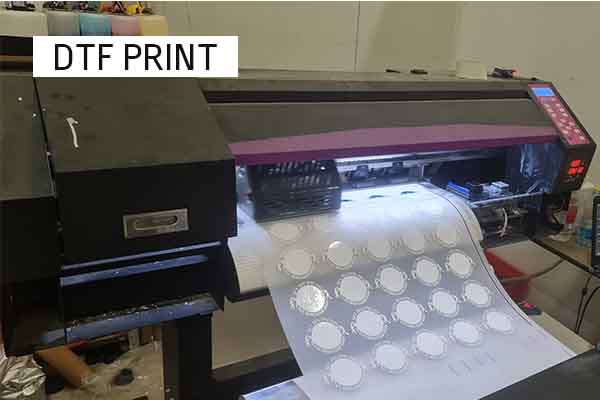Grasping DTF Printing: A Comprehensive Overview to Direct-to-Film Techniques
The Future of Style: Exploring DTF Printing Modern Technology in the Textile Sector
In the last few years, the fabric industry has actually seen a significant shift in the direction of innovative innovations that are improving the landscape of fashion manufacturing. Among these improvements, Direct to Film (DTF) printing modern technology has arised as a promising competitor, supplying one-of-a-kind capabilities and possibilities for designers and producers alike. This sophisticated printing method has actually triggered interest because of its possible to revolutionize standard fabric printing processes. As we look into the effects and possibilities of DTF technology in the realm of style, it comes to be evident that its combination might redefine sector standards and lead the way for a brand-new period of imaginative expression and efficiency.
Development of Textile Printing
From the ancient civilizations using techniques like block printing to the electronic transformation of today, fabric printing has continually pressed boundaries. As the craft spread to other parts of the globe, new approaches such as display printing and roller printing emerged during the Industrial Change, changing the textile market.
The introduction of electronic fabric printing in the late 20th century noted a considerable shift towards more flexible and lasting printing approaches. The advancement of textile printing showcases an abundant history of creativity, resourcefulness, and technical progression in the world of style and design.
Advantages of DTF Modern Technology
With the evolution of textile printing techniques from old techniques like block printing to modern developments such as electronic printing, the intro of Direct-to-Fabric (DTF) modern technology has substantially enhanced the performance and sustainability of fabric printing procedures. One of the primary advantages of DTF innovation is its capability to straight print layouts onto textile without the demand for transfer documents, which lowers waste and simplifies the production procedure. Furthermore, DTF printing enables higher shade vibrancy and information precision contrasted to conventional approaches, making it possible for textile producers to produce high-quality and elaborate styles easily.
Additionally, DTF innovation is understood for its flexibility, as it can be made use of on numerous sorts of textiles, including natural fibers like silk, wool, and cotton, as well as artificial materials such as polyester and nylon (DTF Printing). This adaptability opens up a broad variety of possibilities for makers and designers to experiment with various appearances and materials, resulting in even more unique and cutting-edge products in the fashion business. Overall, the implementation of DTF modern technology stands for a considerable development in fabric printing, using numerous benefits that add to the future sustainability and creativity of the market
Sustainability in vogue Manufacturing
Emphasizing eco-friendly techniques is critical in modern fashion manufacturing, aligning with the expanding consumer demand for lasting products. In the last few years, the garment industry has dealt with increasing examination due to its considerable ecological impact, consisting of excessive water usage, chemical air pollution, and textile waste. As an action, many fashion brand names are now integrating lasting techniques into their manufacturing procedures to minimize damage to the setting.
Sustainability in fashion production incorporates numerous aspects, such as utilizing natural and recycled materials, minimizing power intake, implementing honest labor techniques, and advertising openness throughout the supply chain. Additionally, improvements in modern technology, like DTF printing, deal opportunities to even more improve sustainability in fabric production. This modern technology makes it possible for precise printing on materials, minimizing ink waste and water use contrasted to typical printing approaches.
Design Freedom and Customization

Moreover, DTF printing promotes personalization on a scale formerly unattainable, permitting customized clothing and one-of-a-kind pieces tailored to specific preferences. Customers can now actively join the style procedure, producing garments that mirror their design and personality. This modification look these up not only boosts the customer experience but additionally promotes a feeling of exclusivity and uniqueness in a market filled with mass-produced clothing. On the whole, DTF printing innovation revolutionizes the style landscape in the textile market, offering limitless possibilities for innovative expression and personalized style.
Effect on Supply Chain & Market Trends
DTF printing innovation in the textile industry is reshaping supply chain characteristics and affecting market patterns with its effectiveness and customization capabilities. By enabling on-demand printing and removing the demand for big inventories, DTF technology simplifies the supply chain procedure.
Moreover, the personalization potential of DTF printing innovation is go changing the market patterns in the fabric industry. As a result, DTF modern technology is driving a shift in the direction of even more customer-centric and ingenious approaches within the textile sector, shaping the future of style.

Conclusion
Finally, DTF printing technology is reinventing the fabric industry by using countless benefits such as style sustainability, liberty, and modification. This ingenious modern technology is official website improving the future of fashion production, impacting supply chains, and driving market patterns in the direction of extra environment-friendly and reliable techniques. As the sector proceeds to evolve, DTF printing will play an important function in forming the means fabrics are generated and eaten in the years ahead.
From the old human beings making use of strategies like block printing to the electronic change of today, fabric printing has actually consistently pressed limits. As the craft spread to other parts of the world, new approaches such as display printing and roller printing arised during the Industrial Transformation, transforming the textile industry.
The intro of electronic textile printing in the late 20th century marked a significant change in the direction of more sustainable and versatile printing techniques.With the evolution of textile printing strategies from old methods like block printing to modern technologies such as electronic printing, the introduction of Direct-to-Fabric (DTF) technology has actually substantially improved the efficiency and sustainability of fabric printing processes (DTF Printing).In response to the important change in the direction of sustainability in fashion manufacturing, the adoption of innovative modern technologies like DTF printing not just addresses environmental problems however also opens up methods for exceptional design liberty and personalization in the fabric market